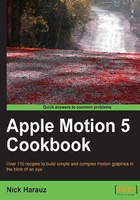
Moving and trimming layers in the Timeline and the mini-Timeline
So eventually as Motion graphic designers, we're going to have to animate stuff and part of that battle lies is our ability to move around and adjust layers efficiently in the application.
There are two ways by which we can adjust the timing as well as trim layers in Motion—by using the Timeline and mini-Timeline. The big question is why choose one over the other. As of Motion 5, both areas are displayed as soon as you enter a project. The Timeline will show all of your layers and the relationship those layers have with one another, spread over time.
The mini-Timeline only shows the selected element from the Layers tab (that is, filter, behavior, clip, and so on).
The Timeline is great for making timing adjustments when they revolve around the relation of one layer to another. On the other hand, the Timeline can become a very busy place, very quickly. The mini-Timeline is a great place to focus in on the selected item at hand. Let's have a look at adjusting layers in both the areas.
How to do it...
- From this chapter's exercise files, open the
01_08project. - There are two groups in this project; a text group and background. Press the Space bar to play the project.
- This animation was done with behaviors, which we'll explore in Chapter 3, Making It Move with Behaviors. Simply, one text layer fades in after another. Before fixing the timing of the text, you may have noticed that the text appears off alignment. Click on the Disclosure tab for the Text group and click on the THREE layer and Shift + click the ONE layer. From the Object menu select Alignment | Distribute Vertical Centers. Your text is now distributed evenly.
- In the following screenshot, you can see the order of our number layers in the Timeline. We want to change the order of the layers by fading in the first layer, followed by the second, and the third. We're going to make our first change in the mini-Timeline. To hide the Timeline temporally, go to Window | Timeline. Select the THREE layer, and from the Mark menu, choose Go To | Selection In Point. We want ONE to begin at
1second. Select ONE and drag the layer's in-point value until it reads00:00;01:00.
- Move your playhead to the beginning of the Timeline by pressing the home key or Fn + ← on a laptop. Play the animation. While the ONE layer now fades in at the same time as the THREE layer, you'll notice that it cuts off at the end. Drag the ONE layer's out-point in the mini-Timeline so it lasts till the end of the project.
- Let's finish the rest our work in our Timeline. Press Command + 7 to toggle back to the Timeline.
- Let's move the THREE layer to where the TWO layer ends. Drag the THREE layer while holding down the Shift key. Wait for its in-point to snap to the TWO layer's out-point and then release the mouse.
- Make sure nothing is selected by pressing Shift + Command + A. Type
2, followed by the return to move to the two-second mark. Select the TWO layer and press I to trim its in-point to the playhead. - Press the home key and then the Space bar to check if the timing works. Use the following screenshot to guide you:

There's more...
You can move your playhead by entering in numeric values. It's a good habit to make sure no layer is selected before attempting this operation. Press Shift + Command + A. Now, press Shift + = + 1 + . followed by Enter to move the playhead one second forward. Press – + 1 + . and hit Enter to move the playhead one second back, and press 5 + . and hit Enter to move the playhead to approximately five seconds.
You can move layers the same way you move your playhead. Select the layer you want to move in the Timeline and press Shift + =, or the minus symbol, followed by the number of frames or seconds you want to move it by.